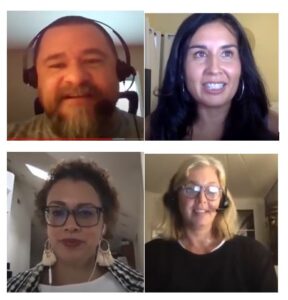Tag: incarceration
“Checking the Boxes” – A panel on race, ethnicity, and the Census
Although we don’t always think of it that way, one federal government program that affects each of us in the United State is the decennial census. And among the challenges of many kinds that a pandemic has brought us, its effects on gathering good quality census data is high on the list.
Earlier this year, the Library hosted a well-attended (physical) exhibit related to the census, Power and the People: The US Census and Who Counts (which can still be experienced online). Related to the exhibit, we were on board with our plan to host a panel of campus experts on the contested race and ethnicity questions in the census, and how they’ve shifted over time…. Until March 17, when the Bay Area went into a shelter-in-place order and the program had to be postponed. But last month, thanks to a persistent team, generous panelists, and the wonders of Zoom, we were thrilled to able to present the panel at last, online!
The program, titled Checking the Boxes: Race(ism), Latinx and the Census, featured three UC Berkeley experts on racial and ethnic categorizations in the census. Cristina Mora (Associate Professor of Sociology and Chicano/Latino studies), Tina Sacks (Assistant Professor, School of Social Welfare), and Victoria Robinson (Lecturer and American Cultures Program Director, Department of Ethnic Studies) were joined by our moderator, librarian Jesse Silva, for presentations and a lively Q&A.
Professor Mora started the program off with the information that “ethnic and race categories are political constructs… They are not set-in-stone scientific markers of identity or genetic composition.” She noted that since the census counts are directly related to funding, communities have a vested interest in getting accurate and complete counts, but this can be very difficult for groups and areas that are designated Hard to Count. Professor Sacks continued by emphasizing the ways in which census-driven funding allocations can affect people in poverty and those in social safety net programs. She also noted the intersections shown by census data between race and place, such as areas with a substantial number of incarcerated people. Finally Professor Robinson added background and context by discussing the site racebox.org, which shows the history of the race questions on the census from 1790 onwards, and which illuminates the changes in the cultural and social conceptions of what race is and how it can be measured.
The program concluded with an animated question and answer period, which included Professor Mora’s elaborating on the differences between racial and ethnic categories, Professor Sacks (who has actually been a census enumerator) discussing the challenges of counting the homeless population, and Professor Robinson revisiting the question of incarceration and the Attica problem: “[Incarcerated people’s] residence is considered to be a prison. That’s not their home, and the relationship then to the power…in the communities that they [aren’t from], that’s the Attica problem.”
Of course, this summary doesn’t do justice to the range and depth of the issues discussed. If you missed this program, or would like to see it again, check it out on the UC Berkeley Library’s YouTube channel!

